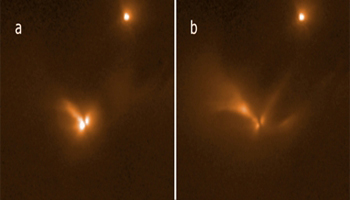`Hungry twin` stars emit infrared light bursts while gobbling their first meals
 Washington, Feb 1 : Astronomers have reported observing an unusual "baby" star that periodically emits infrared light bursts, suggesting it may be twins, that is, a binary star.
Washington, Feb 1 : Astronomers have reported observing an unusual "baby" star that periodically emits infrared light bursts, suggesting it may be twins, that is, a binary star.
The extremely young object, dubbed LRLL 54361, is about 100,000 years old and is located about 950 light years away toward the Perseus constellation.
Years of monitoring its infrared with the Spitzer instrument reveal that it becomes 10 times brighter every 25.34 days, the researchers said
This periodicity suggests that a companion to the central forming star is likely inhibiting the infall of gas and dust until its closest orbital approach, when matter eventually comes crashing down onto the protostellar "twins."
"The idea that this object is a baby binary system fits our data, so, twins fit our data. In single protostars, we would still see matter dumping onto the star non-uniformly, but never with the regularity or intensity of the bursts we observe in LRLL 54361. The 25.43-day period is consistent with the orbital period we would expect from a very close binary star," said Robert Gutermuth, a University of Massachusetts Amherst expert in imaging data from the Spitzer Space Telescope.
The protostar twins, embedded in a gas "cocoon" many times larger than our solar system, offer an unusual chance to study what looks like a developing binary star system, he added. Because dense envelopes of gas and dust surround embryonic stars, the only detectable light to escape is at longer, infrared wavelengths.
"Spitzer's infrared camera is perfect for penetrating this cool dust to detect emission from the warm center," said Gutermuth.
"When you have two young stars feeding from the same circumstellar disk, the gravitational influence of the secondary companion can cause hiccups, an inhibition of infalling material from the disk. But when the orbital paths approach closely, that material can rush in, triggering feeding pulses for both stars and releasing a bright burst of light. The flash moves out from the center, reflecting off the disk and cavities in the envelope like an echo reverberating out from cave walls. We've seen the light flashes with Spitzer and have imaged the echo-tracing cavities in its envelope with the Hubble Space Telescope," he added.
The investigators are careful to point out that they're not sure what is at the center of object LRLL 54361, but if it is an embryonic binary star, the prospects are exciting.
The discovery is reported this month in Nature. (ANI)